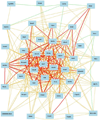Cell cycle gene expression networks discovered using systems biology: Significance in carcinogenesis
- PMID: 25808367
- PMCID: PMC4481160
- DOI: 10.1002/jcp.24990
Cell cycle gene expression networks discovered using systems biology: Significance in carcinogenesis
Abstract
The early stages of carcinogenesis are linked to defects in the cell cycle. A series of cell cycle checkpoints are involved in this process. The G1/S checkpoint that serves to integrate the control of cell proliferation and differentiation is linked to carcinogenesis and the mitotic spindle checkpoint is associated with the development of chromosomal instability. This paper presents the outcome of systems biology studies designed to evaluate if networks of covariate cell cycle gene transcripts exist in proliferative mammalian tissues including mice, rats, and humans. The GeneNetwork website that contains numerous gene expression datasets from different species, sexes, and tissues represents the foundational resource for these studies (www.genenetwork.org). In addition, WebGestalt, a gene ontology tool, facilitated the identification of expression networks of genes that co-vary with key cell cycle targets, especially Cdc20 and Plk1 (www.bioinfo.vanderbilt.edu/webgestalt). Cell cycle expression networks of such covariate mRNAs exist in multiple proliferative tissues including liver, lung, pituitary, adipose, and lymphoid tissues among others but not in brain or retina that have low proliferative potential. Sixty-three covariate cell cycle gene transcripts (mRNAs) compose the average cell cycle network with P = e(-13) to e(-36) . Cell cycle expression networks show species, sex and tissue variability, and they are enriched in mRNA transcripts associated with mitosis, many of which are associated with chromosomal instability.
© 2015 Wiley Periodicals, Inc.
Conflict of interest statement
No Conflict of Interest
Figures










References
-
- Aguilar R, Grandy R, Meza D, Sepulveda H, Pihan P, van Wijnen AJ, Lian JB, Stein GS, Stein JL, Montecino M. A functional N-terminal domain in C/EBPbeta-LAP* is required for interacting with SWI/SNF and to repress Ric-8B gene transcription in osteoblasts. J. Cell. Physiol. 2014;229:1521–1528. - PMC - PubMed
-
- Aziz F, van Wijnen aJ, Stein JL, Stein GS. HiNF-D (CDP-cut/CDC2/cyclin A/pRB-complex) influences the timing of IRF-2-dependent cell cycle activation of human histone H4 gene transcription at the G1/S phase transition. J. Cell. Physiol. 1998;177:453–464. doi:10.1002/(SICI)1097-4652(199812)177:3<453::AID-JCP8>3.0.CO;2-F. - PubMed
-
- Blagosklonny MV, Pardee AB. The restriction point of the cell cycle. cc. 2002;1:103–110. - PubMed
Publication types
MeSH terms
Substances
Grants and funding
LinkOut - more resources
Full Text Sources
Other Literature Sources
Miscellaneous

